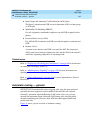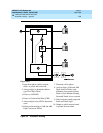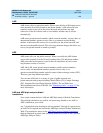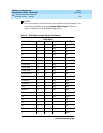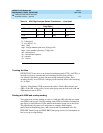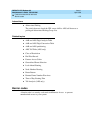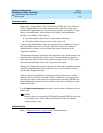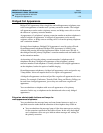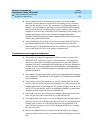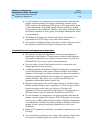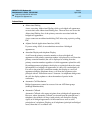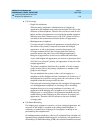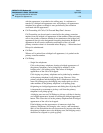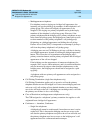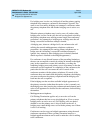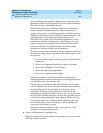
DEFINITY ECS Release 8.2
Administrator’s Guide
555-233-506
Issue 1
April 2000
Features and technical reference
1175Bridged Call Appearance
20
■ You can administer the call forwarding all calls and call forwarding
busy/don’t answer buttons to activate Call Forwarding for any extension
that is on the telephone, even if this extension is a bridged appearance. In
addition, you can administer the lamp associated with the call forwarding
button to track the call forwarding status of any extension. In this way, a
bridged user can activate or deactivate Call Forwarding for all primary and
bridged appearances of the extension from the bridged appearance
telephone, and the bridged appearance telephone shows the call forwarding
status of the specified extension.
■ You can administer the send all calls button to activate Send All Calls for
any administered extension. The lamp associated with Send All Calls
tracks the status of the administered extension. In this way, a bridged user
can activate Send All Calls for the primary extension user.
Considerations for single-line telephones
■ The number of bridged call appearances allowed varies by system. See
DEFINITY ECS System Description for those numbers. A bridging user
cannot have more than one bridged appearance for a particular primary
telephone. However, a multiappearance bridging user can have appearances
of more than one analog telephone on their telephone (a multiappearance
bridging user, by use of different buttons, can bridge onto several different
primary telephones).
■ The number of bridged appearances allowed on a multiappearance bridging
user’s telephone is limited only by the number of 2-lamp buttons available
on the telephone.
■ If the primary single-line telephone is correctly administered, but not in
service, calls can still be placed by the bridging users, and received on the
bridged appearances of the telephone. The primary telephone can be out of
service for several reasons, such as an unplugged telephone, a nonexistent
telephone system technician busyout command, etc.
■ If more than one user goes off-hook on a bridged appearance at the same
time, only the user who was the first to go off-hook can dial.
■ If a bridging user is not active on a call, and bridges onto the appearance of
an active call, the user is bridged onto the active call. If a multiappearance
bridging user is active on a call, and bridges onto the appearance of an
active call, the previously selected call is dropped and the user is bridged
onto the active call.
■ The Privacy-Manual Exclusion feature can be activated by the bridging
user only, while active on a call, to prevent accidental bridging of an active
call.



